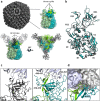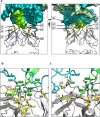Antibody-antigen kinetics constrain intracellular humoral immunity
- PMID: 27881870
- PMCID: PMC5121590
- DOI: 10.1038/srep37457
Antibody-antigen kinetics constrain intracellular humoral immunity
Erratum in
-
Corrigendum: Antibody-antigen kinetics constrain intracellular humoral immunity.Sci Rep. 2017 Apr 6;7:45418. doi: 10.1038/srep45418. Sci Rep. 2017. PMID: 28382939 Free PMC article. No abstract available.
Abstract
During infection with non-enveloped viruses, antibodies stimulate immunity from inside cells by activating the cytosolic Fc receptor TRIM21. This intracellular humoral response relies on opsonized viral particles reaching the cytosol intact but the antigenic and kinetic constraints involved are unknown. We have solved the structure of a potent TRIM21-dependent neutralizing antibody in complex with human adenovirus 5 hexon and show how these properties influence immune activity. Structure-guided mutagenesis was used to generate antibodies with 20,000-fold variation in affinity, on-rates that differ by ~50-fold and off-rates by >175-fold. Characterization of these variants during infection revealed that TRIM21-dependent neutralization and NFκB activation was largely unaffected by on-rate kinetics. In contrast, TRIM21 antiviral activity was exquisitely dependent upon off-rate, with sub-μM affinity antibodies nevertheless unable to stimulate signaling because of fast dissociation kinetics. These results define the antibody properties required to elicit an efficient intracellular immune response during viral infection.
Figures





Similar articles
-
TRIM21 Immune Signaling Is More Sensitive to Antibody Affinity Than Its Neutralization Activity.J Immunol. 2016 Apr 15;196(8):3452-3459. doi: 10.4049/jimmunol.1502601. Epub 2016 Mar 9. J Immunol. 2016. PMID: 26962230 Free PMC article.
-
Crystal structure of CD27 in complex with a neutralizing noncompeting antibody.Acta Crystallogr F Struct Biol Commun. 2017 May 1;73(Pt 5):294-299. doi: 10.1107/S2053230X17005957. Epub 2017 Apr 26. Acta Crystallogr F Struct Biol Commun. 2017. PMID: 28471362 Free PMC article.
-
Crystal structures of human Fabs targeting the Bexsero meningococcal vaccine antigen NHBA.Acta Crystallogr F Struct Biol Commun. 2017 Jun 1;73(Pt 6):305-314. doi: 10.1107/S2053230X17006021. Epub 2017 May 11. Acta Crystallogr F Struct Biol Commun. 2017. PMID: 28580917 Free PMC article.
-
TRIM21: a cytosolic Fc receptor with broad antibody isotype specificity.Immunol Rev. 2015 Nov;268(1):328-39. doi: 10.1111/imr.12363. Immunol Rev. 2015. PMID: 26497531 Free PMC article. Review.
-
TRIM21-From Intracellular Immunity to Therapy.Front Immunol. 2019 Aug 28;10:2049. doi: 10.3389/fimmu.2019.02049. eCollection 2019. Front Immunol. 2019. PMID: 31555278 Free PMC article. Review.
Cited by
-
Intracellular antibody signalling is regulated by phosphorylation of the Fc receptor TRIM21.Elife. 2018 Apr 18;7:e32660. doi: 10.7554/eLife.32660. Elife. 2018. PMID: 29667579 Free PMC article.
-
Computational modeling of microfluidic data provides high-throughput affinity estimates for monoclonal antibodies.Comput Struct Biotechnol J. 2021 Jun 17;19:3664-3672. doi: 10.1016/j.csbj.2021.06.024. eCollection 2021. Comput Struct Biotechnol J. 2021. PMID: 34257845 Free PMC article.
-
Improvement in affinity and thermostability of a fully human antibody against interleukin-17A by yeast-display technology and CDR grafting.Acta Pharm Sin B. 2019 Sep;9(5):960-972. doi: 10.1016/j.apsb.2019.02.007. Epub 2019 Feb 22. Acta Pharm Sin B. 2019. PMID: 31649846 Free PMC article.
-
Complement C4 Prevents Viral Infection through Capsid Inactivation.Cell Host Microbe. 2019 Apr 10;25(4):617-629.e7. doi: 10.1016/j.chom.2019.02.016. Epub 2019 Mar 26. Cell Host Microbe. 2019. PMID: 30926239 Free PMC article.
-
A functional assay for serum detection of antibodies against SARS-CoV-2 nucleoprotein.EMBO J. 2021 Sep 1;40(17):e108588. doi: 10.15252/embj.2021108588. Epub 2021 Jul 29. EMBO J. 2021. PMID: 34323299 Free PMC article.
References
Publication types
MeSH terms
Substances
Grants and funding
LinkOut - more resources
Full Text Sources
Other Literature Sources

